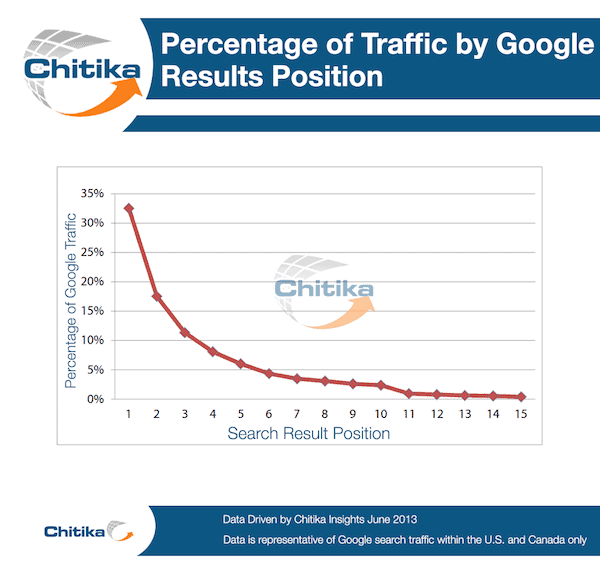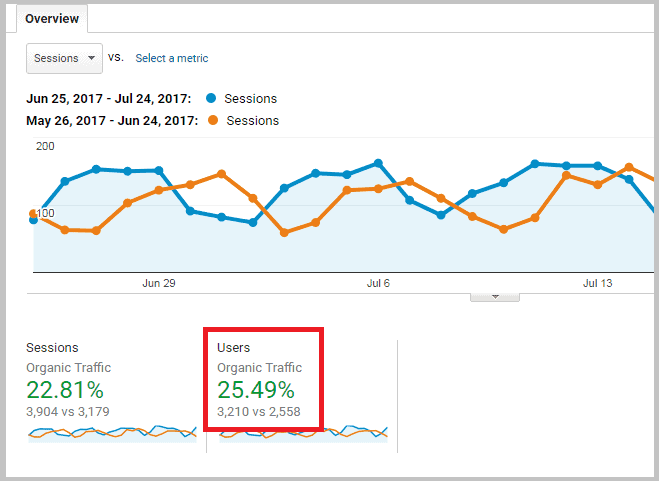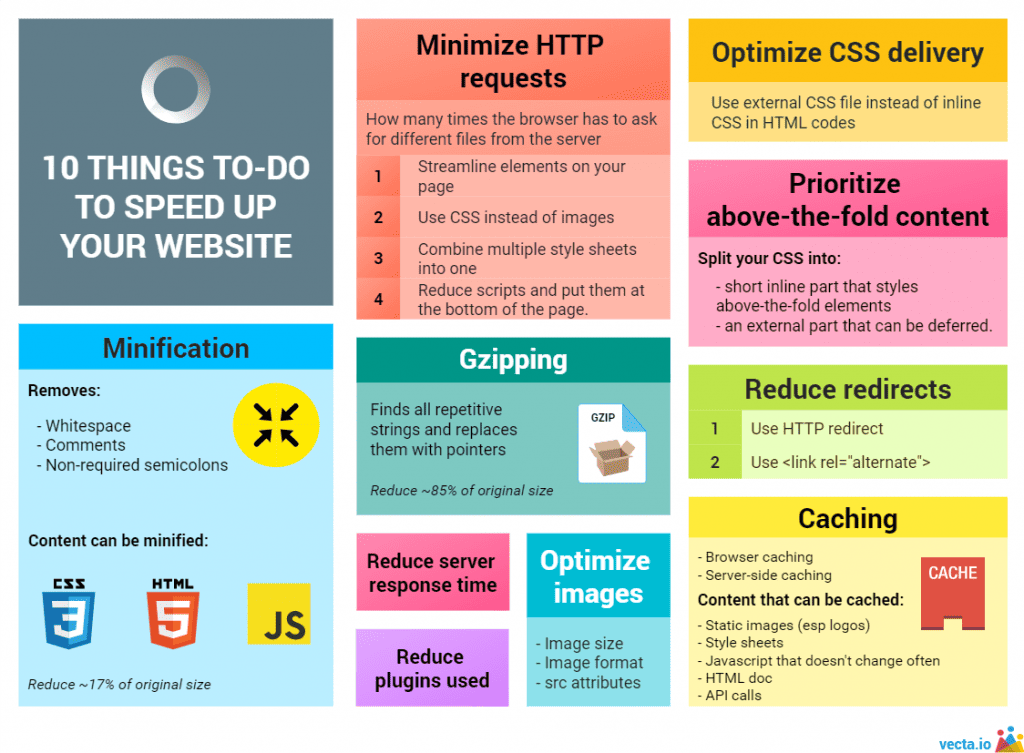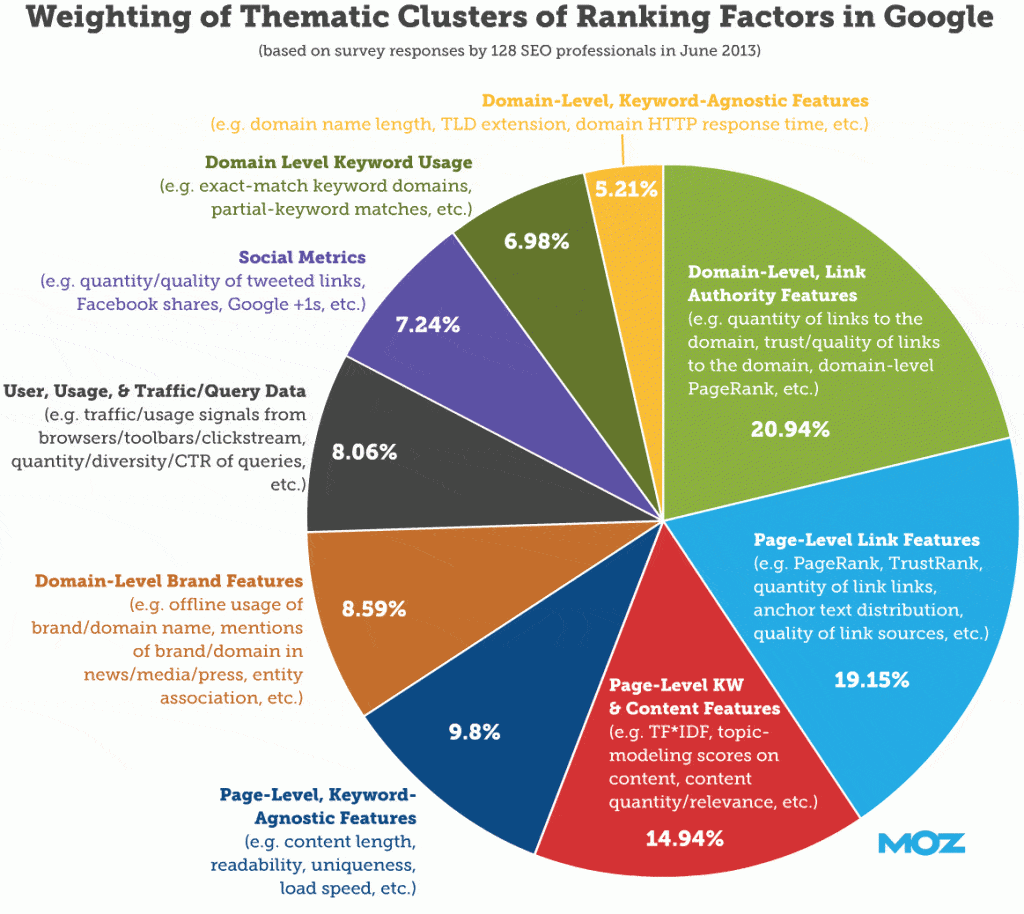Why do we create content?
Bottom line, it’s about being seen in a digital world. Through content, we can share our message and solutions so we can attract and keep our best customers.
But what good does it do to create content if it’s never seen? Unless we get eyeballs on our content, we won’t attract or persuade anyone.
That’s what makes SEO a key player in your content strategy. We need traffic so we can convert it to sales.
According to a study by online ad network Chitika, the #1 position in Google search results gets 33% of the traffic. Traffic to the #2 position isn’t even close, with just 18% of the traffic. And it’s all downhill from there.

So how do you improve your SEO?
MyTasker has put together an infographic that shares 11 smart tactics to improve your search traffic—and your user experience and usability too.
What caught my attention were the results they got from these strategies. Take a look:

These SEO tips boosted MyTasker’s organic traffic 25% in just 30 days.
11 Smart SEO Tips to Boost Traffic FAST

SEO Checklist
These 11 SEO tips will help you raise the quality of your site, build trust, and boost your search rank and traffic. So it’s important to implement them on your site.
That being the case, here’s a quick-reference SEO checklist to help you optimize your site for fast results.
Reduce your page load time.
A mere 2-second increase in load time (from 1 second to 3 seconds), increases the likelihood visitors will bounce by 32%.
Wondering how to do that? Here are some tips I shared in an article for Crazy Egg. (Hat tip to Vecta.io for creating this graphic.)

Make your site responsive.
Your site should be easy to read and navigate on all devices: phones, tables, and desktops. Most templates these days are automatically responsive, but you need to review your pages from all devices to be sure.
Two themes I recommend: Genesis (I like their child theme, Parallax Pro) and Thrive Themes.
Use long-tail keywords.
When people are looking for answers, they don’t search for the top-level keyword. They ask specific long-tail questions.
Not only that, it’s easier to rank for long-tail terms than broad topical terms. If you use a keyword research tool, you’ll notice they get much lower search volume. That’s okay. Though they aren’t searched as often, it’s much easier to rank for them. And since these searches are more specific, content that’s optimized for long-tail keywords is more likely to convert well.
TIP: Create a page on your blog for each question your prospects or customers ask. Make sure you provide complete answers and that your pages are at least 400 words.
Publish high-quality content.
Your content needs to be focused on your brand topic so search engines recognize you as an authority on your topic. Your content needs to be consistently relevant, actionable, and helpful.
How do you create content that’s optimized for search engines? Here’s the guide.
Keep your site relevant.
Most blogs have a target audience and cover a specific topic or theme. To maintain relevance to your audience, you should avoid publishing content that doesn’t fit under the umbrella of your core topic.
Then, to keep it relevant, regularly update and republish your old blog posts. Raise their quality and relevance. And don’t forget to create internal links to related content.
Additional Reading: 10 Tips to Increase the Value of Your Business Blog
Build natural backlinks.
Lots of backlinks can help you rank better. But if those links come from low-quality sites, you may actually hurt rather than help your SEO.
According to Moz, more than 20% of Google’s ranking factors has to do with the trustworthiness or quality of your backlinks.

Backlinks need to be high quality, so don’t build links from just any old site. Get backlinks from well-respected, relevant sites that are related topically to your website.
According to Dana Zarcone, there are 8 criteria for a link to be considered high quality.
- Site credibility
- Site TrustRank
- Niche relevance
- Positioned where it’s seen and drives traffic
- Included in editorial content (as opposed to footers or sidebars)
- Not “in-kind” or the result of a link exchange
- Timeliness (links lose potency over time)
- Coming from social media
Optimize for voice search.
Today, searches are often made through intelligent assistants such as Amazon’s Echo and Apple’s Siri. To optimize for these devices, include conversational search terms in your content, and create sections that provide quick answers.
Switch your site to HTTPS.
HTTPS stands for Hyper Text Transfer Protocol Secure. The difference between HTTP and HTTPS is that last word, “secure.” When you implement HTTPS on your website, all communications between the browser and your site are encrypted.
As mentioned above, trust is a big deal in SEO—for your visitors and search engines too.
In case you’re worried, this is an easy change. Your host probably offers an SSL certificate. Once you have that, just check a box in your admin and you’re set.
Be present and active on social media.
While we aren’t sure whether social links boost your search rank, they do help search engines understand what your site is about and identify it as credible. Here’s what we do know…
Search engines crawl social sites in the same way they crawl other sites. The question is whether they use that data.
Bing has said they do look at this data. In particular, they’re interested in how often a link has been shared and the authority of the people sharing it. Google probably doesn’t take the authority of the social account into consideration, but they may recognize social shares as backlinks.
Either way, social media allows you to expand your network, promote your content, and engage your audience. And if it also helps you rank better, it’s a no-brainer.
Optimize for all search engines.
Google isn’t your only option. Remember, Bing and Yahoo can also send you traffic.
And yes, Google still holds the top spot among search engines, as of 2016, they only control 63.8% of search traffic. That means other search engines are responsible for nearly 40%, and traffic coming from those search engines often converts better.
So how do you optimize for other search engines?
While most of your optimization efforts will work across the board, there are a few differences. This article by Neil Patel will tell you what you need to know.
Create a stellar user experience.
Google doesn’t want you to get so focused on SEO that you forget the end user—web browsers who are looking for answers to their burning questions. Which means you need to have high-quality content that provides helpful answers, and you need to make it easy to find that content.
When people arrive on your site, don’t make them think or work to figure out where useful information is. Create an intuitive and customer-focused experience, and your visitors will spend more time on your site.
Bottom Line
SEO is an important tactic for driving traffic, but it’s gotten a lot of bad press since Google began updating their algorithms.
But SEO had become a manipulative game, aimed at beating the system. All Google has done is remove the rewards for unethical online behavior.
If you want new and returning traffic from your best customers, learn the SEO tips listed in this article. Then put all your energy into serving your audience.
What value do you offer? What solutions?
Make that the focus of your business, and many of your SEO challenges will solve themselves.


